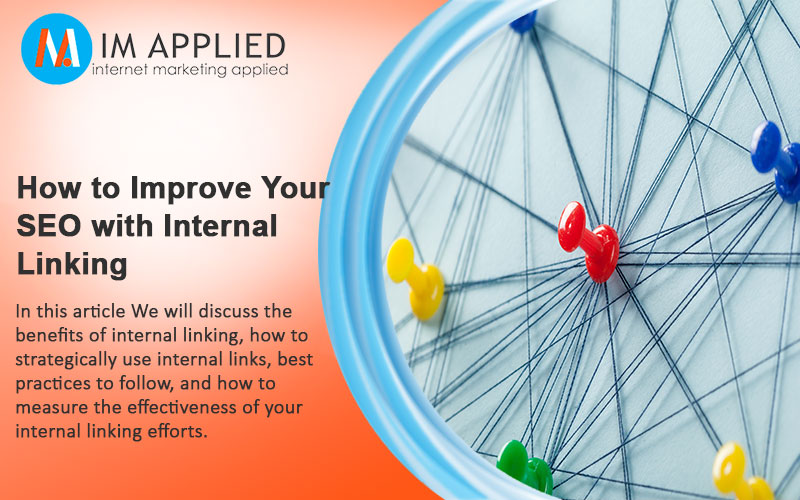How does content marketing elevate your SEO and engage your target audience? By crafting valuable content tailored to your audience’s needs, content marketing boosts search rankings and builds brand trust.
This guide unpacks seven key strategies revealing how content marketing is the engine for your SEO success and online growth.
We provide professional SEO services here at IMApplied, if you would like us to do the heavy lifting for your your marketing and SEO needs, you can book a free 20 minute discovery call with us!
Key Takeaways
- A successful content marketing strategy enhances SEO and relies on diverse, audience-tailored content such as blogs, videos, and ebooks to engage and build consumer trust.
- Knowing the audience profoundly and aligning content with the stages of the buyer’s journey are critical steps to creating compelling content that increases brand awareness, leads, and conversions.
- Strategic keyword integration and generating high-quality backlinks are essential to improve SEO through content marketing, alongside leveraging social media and paid advertising for broader content distribution.
The Essence of Content Marketing

It’s no secret that content marketing has become a cornerstone of various digital marketing campaigns. It enhances the efforts of SEO, PPC, and social media, creating a compounding effect over time.
The power of content marketing lies in its ability to adapt to diverse audience preferences and learning styles. By utilising a variety of content formats such as:
- blogs
- videos
- podcasts
- whitepapers
- ebooks
brands can foster deeper engagement and trust with their audience. Click here to find out more about digital marketing strategy and tactics.
The beauty of content marketing is that it doesn’t overtly promote a brand. Instead, it establishes a connection with the audience by providing high-quality content that is valuable, relevant, and consistent.
This marketing approach differentiates brands that sell products from those that offer solutions, experiences, and value beyond transactional exchanges.
1. Crafting a Robust Content Marketing Strategy

A robust content marketing strategy is integral to any successful content marketing campaign. It is an art and science that involves setting clear goals, identifying the target audience, and aligning content with the buyer’s journey.
Such a strategy is not fixed but should be evaluated and refined regularly to adapt to changes in the market and audience preferences, as well as to maintain a competitive edge.
Establishing Clear Goals
Clear and measurable goals form the foundation of any successful content marketing strategy. These objectives range from attracting traffic and increasing brand awareness to generating leads. But how does one ensure these goals are realistic and achievable?
The answer lies in the SMART criteria. By ensuring that goals are Specific, Measurable, Achievable, Realistic, and Time-Bound, brands can create a clear purpose in their content marketing efforts.
However, rigidity can be a setback in the ever-changing digital marketing landscape.
Goals in content marketing should be flexible, adapting to shifts in market conditions and consumer expectations. It is also crucial to prioritise these objectives, concentrating efforts on urgent needs while aligning with the company’s long-term strategy.
2. Knowing Your Audience Inside Out
Having a clear understanding of your audience is like possessing a compass in the expansive ocean of digital marketing. By identifying target audience demographics such as location, age, gender, employment, and income, brands can create tailored content marketing strategies that resonate with their audience.
However, truly knowing your audience extends beyond mere demographics. It also encompasses understanding their interests, purchase intentions, and subcultures, allowing for the creation of more relatable and effective marketing campaigns.
The benefits of audience understanding extend beyond this. By conducting persona research and collecting data, brands can:
- Create detailed buyer personas, guiding the development of more relevant content
- Revisit these audience parameters annually through market research to grow the audience and refine personas
- Tailor content and make strategic decisions regarding platforms, metrics, and content types based on a deep understanding of the target audience.
Aligning Content With the Buyer’s Journey
The buyer’s journey is a roadmap that guides potential customers from the awareness stage to the final purchase decision. By aligning content with each stage of this journey, brands can improve customer relationships and conversions.
For instance, awareness-stage content, such as blogs and social content, educates potential customers about the brand or problem, serving as the top-of-funnel (TOFU) material to attract leads.
As the potential customer moves to the consideration phase, brands can provide resources such as comparison guides and mid-funnel (MOFU) content to help prospects evaluate solutions and speed up their buying process.
Then, during the decision stage, brands can leverage offers like free trials, consultations, and incentives such as coupons to reduce friction, generate urgency, and drive conversions through bottom-of-funnel (BOFU) content.
Thus, a methodical content strategy must involve choosing suitable content formats and channels based on the target audience’s preferences at each stage of the buying cycle.
3. Leveraging Different Content Formats for Maximum Impact

In content marketing, diversity is of paramount importance. Brands can leverage different content formats, such as blog posts, video content, and infographics, to cater to diverse audience preferences and maximise user engagement.
Each content format has its unique strengths and can be effectively distributed through various channels for maximum impact.
The Power of Blogging
Blogging serves as a potent instrument in content marketing. It allows brands to showcase their expertise and authority, which can help meet Google’s E-A-T guidelines and enhance SEO quality.
Writing a compelling blog post title that includes your focus keyword can make your article more relevant to search queries, while blogs organised by topic clusters can help more pages on your site rank in Google.
But blogging isn’t just about SEO. Regularly updated blogs with fresh content can improve dwell time, signalling the value of the content to search engines. Moreover, incorporating images and videos in blog posts can make them more compelling to users.
And by enhancing readability with headings and bullet points, brands can significantly improve the user experience.
Video Content: A Visual Feast
With attention spans decreasing, video content emerges as a lighthouse of engagement. Unsurprisingly, 91% of consumers want to see more video content from the brands they love.
Effective video content marketing includes sharing product demos and customer testimonials, providing subtitles for accessibility, and focusing on storytelling, among others.
The impact of video marketing is profound. It allows brands to:
- Communicate complex ideas quickly
- Spur other marketing efforts
- Improve ROI
- Build relationships
For instance, Dollar Shave Club’s brand recognition skyrocketed thanks to their innovative use of video content. Similarly, Red Bull’s sponsorship of Felix Baumgartner’s space jump is another testament to the power of video content in marketing.
Infographics: Simplifying Information
The role of visual content in retaining information is hugely significant. Infographics have the power to:
- Transform complicated data sets into visual narratives that are more easily digested and engaging for the audience
- Increase visibility and exposure of content through their shareability
- Provide a compelling storytelling format
You can effectively communicate complex information and captivate your audience by utilising infographics.
Custom-designed infographics can reinforce brand identity and authority, aligning with a company’s branding strategy and fostering brand credibility.
So, whether it’s to present a complex concept in a simplified manner or to make your blog post more engaging, infographics can significantly enhance your content marketing efforts.
4. Enhancing SEO Through Content Marketing

Boosting SEO via content marketing can be likened to stoking the fire. It involves practices like keyword integration, building authority with backlinks, and optimising content for search engines.
These techniques improve the visibility of content and ensure a better user experience, making the content more appealing to both the audience and search engines.
Keyword Integration
Keywords are the stepping stones that lead potential customers to your content. For effective keyword integration, brands should use a primary keyword that determines the main content focus and 3-5 secondary keywords as variations.
Apart from these, additional related long-tail keywords should also be incorporated, considering a total of 3-8 keywords per article.
But it’s not just about adding keywords randomly. Brands need to strategically integrate keywords within:
- The meta description
- SEO title tag
- article titles
- the opening section
- throughout the content
This helps boost the search engine optimisation effectiveness and ensures that the keywords are relevant and inserted naturally into the content, preventing search engine penalties and preserving content quality.
Building Authority with Backlinks
In the SEO sphere, backlinks function as endorsements for your content. They are HTML elements that allow navigation between web pages, including your web page, on the internet.
High-quality backlinks from trusted, relevant sources signal to search engines that the page is an authoritative source, improving its search result position.
Blogging and creating infographics are effective methods for generating content that attracts quality backlinks. However, it’s crucial to avoid poor practices like paid schemes, link exchanges, or spammy practices that can harm your site’s reputation and result in search engine penalties.
Instead, focus on genuinely earning backlinks and providing valuable content that other websites want to refer to.
5. Social Media as a Catalyst for Content Distribution

In today’s digital age, social media has surfaced as a potent facilitator for content distribution. It provides access to a larger pool of potential customers and fosters direct audience feedback, amplifying the reach and impact of content marketing efforts.
Creating a Cohesive Social Media Strategy
Devising a unified social media strategy equates to plotting a roadmap to success.
It involves selecting the proper channels, maintaining a consistent publishing schedule, and tailoring content to each platform’s dynamics.
For instance, sharing updates, offering customer support, and posting content tailored to the platform’s dynamics can dramatically enhance the brand’s social media presence.
The essence of a successful social media strategy lies in understanding each platform’s dynamics. For instance, inspirational stories and custom visuals work wonders on Facebook, while trending topics get more traction on TikTok.
By tailoring the content to suit the platform’s dynamics, brands can effectively engage their audience and build a compelling social media presence.
User Generated Content: Harnessing the Power of the Crowd
Amidst the torrent of online content, user-generated content (UGC) is a beacon leading brands towards authenticity and credibility. UGC is any form of content like:
- images
- videos
- text
- audio
User-generated content (UGC) refers to social media posts that users post online, providing brands with legitimate marketing materials after obtaining permission.
The authenticity of UGC, reflecting honest user experiences, establishes greater trust and enhances credibility between customers and brands.
Moreover, leveraging UGC in marketing strategies amplifies brand visibility and motivates the community to create and share more content, thus fueling a virtuous cycle of engagement.
6. Paid Advertising: Accelerating Content Reach
Although organic reach remains the ultimate goal in content marketing, paid advertising is an effective stimulant to expedite content reach. It generates quicker results and puts content in front of a larger pool of potential customers, enhancing the impact of content marketing efforts.
Decoding Paid Search Ads
Paid search ads, also known as paid ads, can be likened to personal billboards for your content on the digital expressway. They provide immediate visibility on search engines, which is particularly advantageous for new websites or online businesses.
These ads appear above organic search engine results in SERPs and can take various forms, such as:
- Text-only ads
- Shopping ads
- Image carousels
- Videos This immediate visibility is not only beneficial on major search engines like Google but also on other search engines that users may explore.
The control that advertisers have over paid search campaigns is a significant advantage. They can:
- Choose keywords
- Create ad copy
- Design landing pages
- Adjust their strategies based on performance
Moreover, paid search ads on social media platforms can lead to higher conversion rates, as users clicking on these ads are often at the point of purchase.
Social Media Advertising
Social media advertising is akin to wielding a megaphone in a bustling marketplace. It offers advanced options for targeting specific demographics, interests, behaviours, and geographic locations, ensuring content reaches the intended audience.
Paid social media ads, often marked as ‘Sponsored’, can come in several formats, including product carousels and video ads.
The beauty of social media advertising is its versatility. Brands can conduct paid social media campaigns on various platforms, including but not limited to Google, Facebook, and YouTube, based on where the target audience is most active.
Additionally, retargeting ads are a powerful tool in social media advertising, targeting users who have previously engaged with the brand and often resulting in higher conversion rates.
7. Measuring Success: Analytics and KPIs for Content Marketing

Just like any marketing initiative, gauging success in content marketing is vital. It involves tracking analytics and Key Performance Indicators (KPIs) to assess performance against set goals and determine the return on investment (ROI).
Traffic Metrics
Traffic metrics function as the heartbeat of your content marketing strategy. Here are some key metrics to track:
- Views
- User counts
- Pageviews
- Organic search traffic
These metrics provide a clear picture of how many individuals are engaging with your content and the success of attracting the intended audience organically.
The average engagement rate on a website identifies the percentage of significant user interactions, such as event conversions or multiple page views. Similarly, average engagement time reveals the amount of time users spend with content, directly indicating its relevance and quality.
These traffic and engagement metrics are crucial in measuring content effectiveness audience interest, and guiding strategy adjustments for better engagement.
Engagement Metrics
Engagement metrics act as vital signs for your content marketing initiatives. Some essential engagement metrics to consider are:
- Click-through rates
- Social comments
- Shares
- Mentions
- Inbound links
- Page views
- Unique visitors
These metrics gauge user interaction with content and indicate the volume of content consumption and the size of the audience engaged.
Similarly, social media engagement metrics, such as likes, shares, and comments, reflect the content’s resonance with users and its potential to go viral on these platforms.
By optimising content for better engagement, brands can enhance user experience, improve website navigation, reduce bounce rates, and increase content readability.
Summary
In the grand scheme of digital marketing, content marketing is a crucial strategy encompassing various facets, including SEO enhancement, social media integration, and analytics tracking.
By crafting a robust content marketing strategy, leveraging diverse content formats, enhancing SEO, utilising social media, incorporating paid advertising, and measuring success, brands can effectively attract and retain a clearly defined audience, driving profitable customer action.
Frequently Asked Questions
What do you mean by content marketing?
Content marketing involves creating and sharing valuable, relevant content to attract and retain a specific audience, ultimately driving profitable customer action. This approach allows businesses to establish expertise, promote brand awareness, and engage their audience effectively.
Why is it important to align content with the buyer’s journey?
Aligning content with the buyer’s journey is vital because it ensures your content is tailored to each stage of the buying process, ultimately improving customer relationships and conversions.
How does video content enhance content marketing?
Using video content in your marketing strategy enhances engagement, communicates complex ideas effectively, and improves ROI for other marketing efforts.
How can paid advertising accelerate content reach?
Paid advertising can accelerate content reach by generating quicker results and putting the content in front of a larger pool of potential customers, enhancing the impact of content marketing efforts.






















